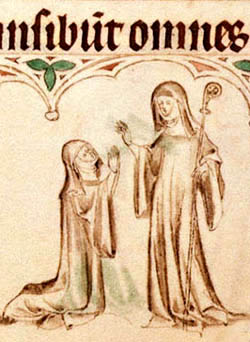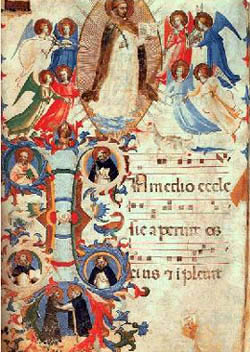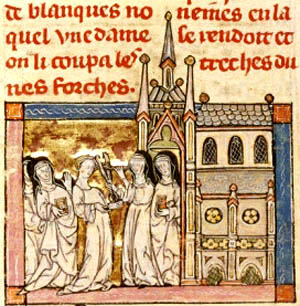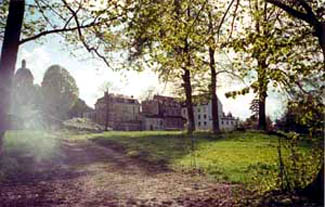 |
The Saint of the Day
St. Fara, April 3
Prof. Plinio Corrêa de Oliveira
Biographical selection:
St. Fara (Burgundofara or Fare) was the daughter of a high noble family of France in the 7th century. In her childhood she was consecrated to God by St. Columbanus, the Apostle of Ireland, who visited and blessed her house in Meaux, France.

A medieval abbess in the Queen Mary Psalter
|
Later her father gave her an estate upon which she built the Convent of Evoriacum which was famous in her time. After her death, it was renamed in her honor and became the Benedictine Abbey of Faremoutiers. As Abbess, she established the rule of St. Columbanus, which was very strict.
The fame of her sanctity quickly spread throughout France and reached England, where many princesses asked to be under the direction of St. Fara. Among these were Saints Sisetrude, Gibitrudis, Hercantrudis, and the English princess Sedrido, who succeeded her as Abbess. Faremoutiers became a school of sanctity where miracles and marvels were common. Often at the deaths of nuns the singing of angelic choirs could be heard throughout the convent as they accompanied the souls of the deceased nuns to Heaven. The spiritual and physical cures were numerous.
Notwithstanding this saintly environment, a few of the disciples of the saint did not profit from her teachings. Some of them succumbed to the Devil’s connivances and died in despair. At the deathbeds of these bad nuns, their companions in horror saw them surrounded by dark shadows that called them by their names.
Even though St. Fara, together with her faithful daughters, were there praying for their souls, Satan received their last breaths and took their souls to Hell. Because they died in despair, their bodies were buried in a nearby field rather than consecrated ground.
During the seasons of Christmas and Easter, flames would appear over their sepulchers, a terrifying example of human fragility! They had abandoned the world, lived amid saints and witnessed miracles. But even though they were surrounded by every kind of supernatural assistance, they did not persevere.
Comments of Prof. Plinio:
This life transmits such a medieval ambience and spirit, it would deserve to be scripted in one of those illuminated manuscripts with a golden background, painted in light colors, having those Nordic-looking personages with faces of angels. One could say that it seems to be a legend, but here it is a history more beautiful than a legend.

St. Fara's life reminds us of Fra Angelico illuminations
|
In this selection we see how the supernatural and the preternatural, with all their vivacity and color, were quite common at that time. We can imagine the marvel of this convent inspired by St. Columbanus. It seems that it was a new convent, built by St. Fara herself on the estate her father gave her, and because of the sanctity of this maiden she was chosen by St. Columbanus to be Abbess.
The luster of her sanctity and rumors of it spread through her province in France and reached England, which in the 7th century was divided into small kingdoms, each with its own royal family. Throughout those seven kingdoms of England the news spread of St. Fara’s sanctity. Many princesses wanted to follow her example and entered her convent as well. We can imagine those courts still in their primitive pomp and luxury, with the parents and relatives of those princesses encouraging them to remain there, enter into noble marriages, and enjoy their lives, possibly even becoming queens. But many of them renounced their privileges and decided to go to that far-off French convent to follow the example of St. Fara.
We can easily picture one of those wonderful farewell scenes: after all her preparations for the journey, a princess kisses her father and mother and leaves the family castle, followed by a small cortege of knights to protect her, under the direction of her guardian who accompanies her on the trip. Some donkeys are carrying her dowry and gifts from the royal family to St. Fara’s convent. The King and the Queen accompany their daughter for some time until they come to a larger road; other courtesans are present as well.
At that point, the cortege travels on alone, disappearing in the horizon. The princess leaves her world and enters the convent.
The ceremony where she receives the habit marks her final separation with the world. Of her own will the princess becomes a slave, so to speak, a religious who starts to serve Our Lord Jesus Christ alone, offering her life to give Him glory.

Medieval noble women being received in a convent - Libre de Lancelot de Lac
|
The marvelous atmosphere of St. Fara’s convent was confirmed by the many miracles that took place there. At their deaths, the souls of the good religious were carried to Heaven by Angels singing in chorus. Their songs were heard by all the nuns and echoed through the convent walls for some time. These were physical miracles. There were also numerous spiritual miracles. We see that in this convent, the cloister, chapel, statues of Our Lady, cells, and halls were impregnated with that supernatural aura found in Fra Angelico’s paintings.
But evil was also present. As in any convent, there were bad nuns there also. Evil entered into its cloisters, but it was obliged to reveal itself. Indeed, those bad nuns who rejected the grace of their vocations and then chose Hell, died with terrible deaths. Before dying shifting shadows surrounded their bodies and coarse voices called them by name, which were also probably heard in different parts of the convent.
Thus, the cloister that had listened to the song of Angels, now heard the roar of devils taking the souls of the bad nuns to Hell. After they were buried, flames would appear over their graves. This was still a mercy of Our Lady for the convent because seeing this, the nuns felt a beneficial horror of vice. It was a way to show how vice and error should be avoided and despised. It was also her mercy that obliged the Devil to show himself amidst such horrible and appropriate symbols.
That living contrast between good and evil inside the convent confirmed the fight between the sons of light and the sons of darkness, established by God in Paradise, when He foretold that Our Lady would smash the serpent’s head: an eternal fight that was, is, and ever will be present in History until the end time.

The Abbey of Faremoutiers, today
|
All this depicts life in the Middle Ages. All this reflects that era of faith when the religious realities appeared in their entire purity and authenticity. They give us not only a great nostalgia for times we did not know, for marvels we did not witness, and for chastisements we did not see, but also they give us a great hope. At Fatima, Our Lady prophesied her triumph, that in the end her Immaculate Heart would triumph. We are sure that many more and much greater marvels are still to happen in this world.
We ask her to imbue our souls not only with nostalgia for that past era of faith, but above all with a hope for this future. An ardent hope should inspire us to do everything that we can to accelerate this future so that the Reign of Mary will come as soon as possible. Making penance for our faults, maintaining our desire for a complete victory for Our Lady, and completely rejecting the present day abominations in the Church and society are the backdrop for this prayer. By our suffering, work, fight, and dedication, by the risks we are willing to face, we should help in the restoration of Christendom and the implantation of her glorious Reign.
Let us ask St. Fara to confirm us in these sentiments on her feast day.


  | | Prof. Plinio Corrêa de Oliveira | |
The Saint of the Day features highlights from the lives of saints based on comments made by the late Prof. Plinio Corrêa de Oliveira. Following the example of St. John Bosco who used to make similar talks for the boys of his College, each evening it was Prof. Plinio’s custom to make a short commentary on the lives of the next day’s saint in a meeting for youth in order to encourage them in the practice of virtue and love for the Catholic Church. TIA thought that its readers could profit from these valuable commentaries.
The texts of both the biographical data and the comments come from personal notes taken by Atila S. Guimarães from 1964 to 1995. Given the fact that the source is a personal notebook, it is possible that at times the biographic notes transcribed here will not rigorously follow the original text read by Prof. Plinio. The commentaries have also been adapted and translated for TIA’s site.
|
Saint of the Day | Home | Books | CDs | Search | Contact Us | Donate

© 2002- Tradition in Action, Inc. All Rights Reserved
|
 |

|